19th-Century Sewing Machine Trade Cards
by D.A. Brumleve
Trade cards were the business cards of the 19th Century. In an age when members of polite society carried calling cards on a routine basis, sewing machine companies and their agents distributed decorative cards with the name of the promoted model and additional information. The dealer would often stamp the name and location of his dealership on the cards and distribute them to potential customers.
The cards I enjoy the most are the ones that feature a company's latest model as the center of attention. Unfortunately, few sewing machine trade cards actually illustrate machines. Most sewing machine trade cards from the late 19th Century show all sorts of things except the machines! There are cows, horses, kittens, flowers, well-behaved and well-dressed children, pastoral landscapes, seasonal foliage -- many, many subjects that have essentially nothing to do with the promoted product, but everything to do with Victorian sensibilities and taste.
The dealers distributing these cards wanted them to be viewed again and again. They wanted the recipients to be mindful of their dealership each time they glanced at the card. By pairing their information with an attractive and decorative picture, the companies hoped that their customers would keep the card -- and the information about their product along with it -- for its decorative value. This strategy worked! Women and girls added trade cards to their scrapbooks or framed them and hung them on the wall. While most scrap paper from this period has long since become kindling for the fire, a wide range of decorative trade cards is still available to us on the antiques market today.
Some cards provide very little in the way of information, while others are a good substitute for an actual catalog, with pictured details of attachments, shuttles, and bobbins, and with text about the company and its machines. Sometimes the reverse side of a card is employed for this purpose. Depending on the text and graphics provided, trade cards can help us track a company and its dealerships, gather statistics on a company's output, and identify changes in models. Collectors restoring machines can get hints from trade cards about a machine's original appearance. Sometimes the cards explain the mysterious contents of a machine's drawers.
Few cards are dated, but the approximate date can often be inferred from the clothing styles and other period-related attributes, type of card stock, and manner of printing. Most early cards were very business-like. A few contain only text, but most had illustrations. Early cards were usually printed on a thicker stock of paper than later cards. Made before the age of four-color lithography, early cards usually used a single color of ink, like this blue-and-white card advertising Howe in 1862 or this black-and-white Finkle & Lyon (Lyon's Mutual) card from around 1870:
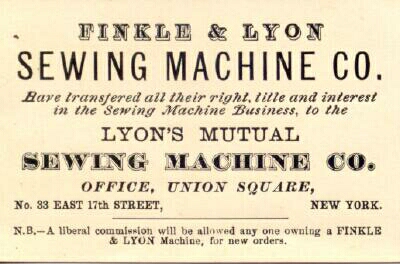
This Howe card dates to the Paris Exposition of 1867:
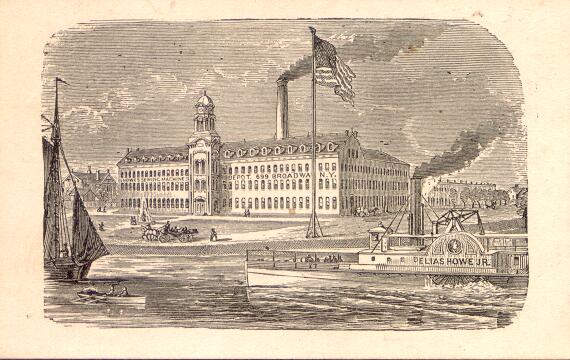
Across the front of the building is written: "Howe Sewing Machines Depot 699 Broadway N.Y." On the side of the steamboat is the name "Elias Howe, Jr."
Though costly, sometimes color was hand-painted on early cards, such as this pastoral scene depicting "Rogers Slide, Sabbath Day Point, and Black Mountain", which advertised Grover & Baker machines in 1864:
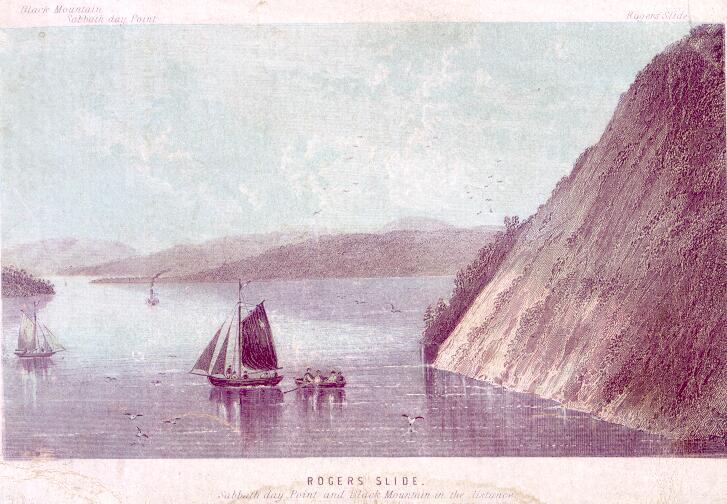
After four-color lithography became available in the mid-1870s, trade cards took on a more significant role in advertising. The color enhanced the cards' decorative value -- and increased the likelihood that a Victorian woman would hold on to them. During the last two decades of the 19th Century, trade cards were enormously popular among dealers and the public alike. Most cards found today date to that time period.
Among the prettiest cards are the fashion-plates which show ladies dressed in beautiful garments made on the sewing machine. Here are two samples of this type:
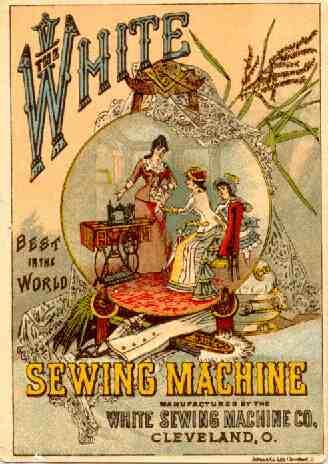
On the left, three ladies are working on a Domestic sewing machine with a commercial pattern which was also produced by Domestic, so the card serves to promote the pattern division of the company as well as the machine. The White Sewwing Machine Co. card depicts a lady's dresser mirror -- and the reflection in the mirror reveals the proud new owner showing off a new White to her friends across the room.
The way to women's hearts was sometimes through their children, and tots were often prominent in domestic scenes. An early example, this McLean & Bennor (McLean & Hooper) card shows a young girl learning to use the machine, a common trade card theme:
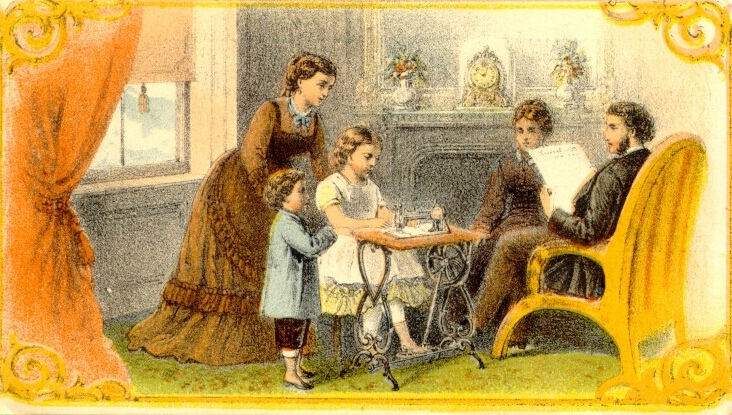
While the following early card for the Howe Model G also shows a full-sized model on the reverse, the front of the card shows a small child using a the same Model G head powered by a scaled-down treadle.
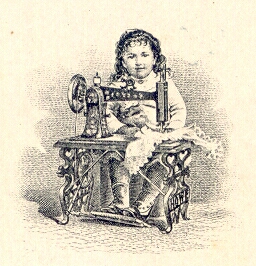
Not only was it important for the growth of the industry for the next generation to learn to sew, but such pictures also included the subliminal suggestion that "it's so simple even a child can do it", thus encouraging aging and old-fashioned seamstresses to try sewing by machine.
Seamstresses who hadn't yet learned to use a machine were also the target of this early advertising card for the American Sewing Machine Co.:
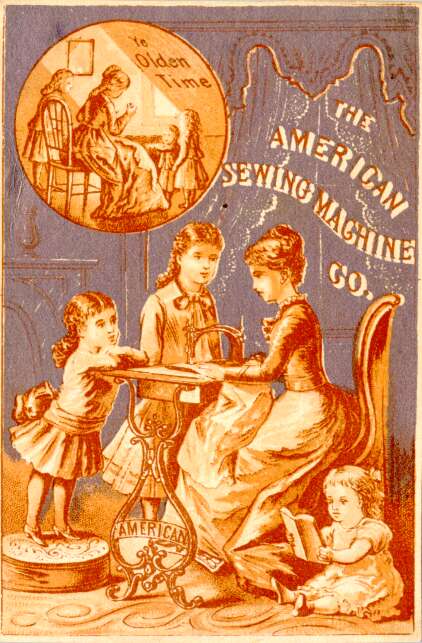
Old Grandma is shown in the inset sewing by hand, whereas the modern mother in the main picture is enjoying the benefits of the Industrial Age. As sewing machines became common fixtures in homes, later cards of this before-and-after variety used the contrast to compare their machines with clunkier older models, encouraging the purchase of a new one. An early example of this genre is provided by Johnson, Clark & Co., then makers of the New Home sewing machine:
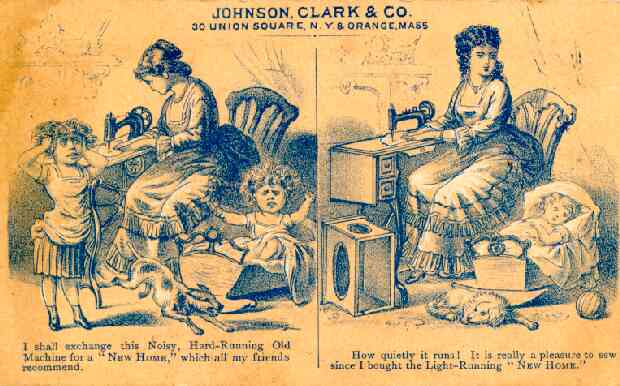
A four-color example promotes the Willcox & Gibbs. This double-width card shows a family in turmoil as Mother sews on a "noisy, hard running, double thread" machine condemned as "A Distressing Nuisance", but domestic tranquility is restored with the simple purchase of a Willcox & Gibbs New Automatic, "A Home Blessing":
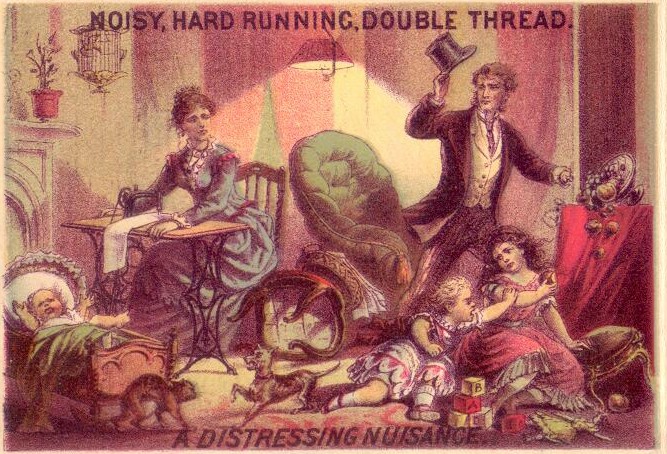
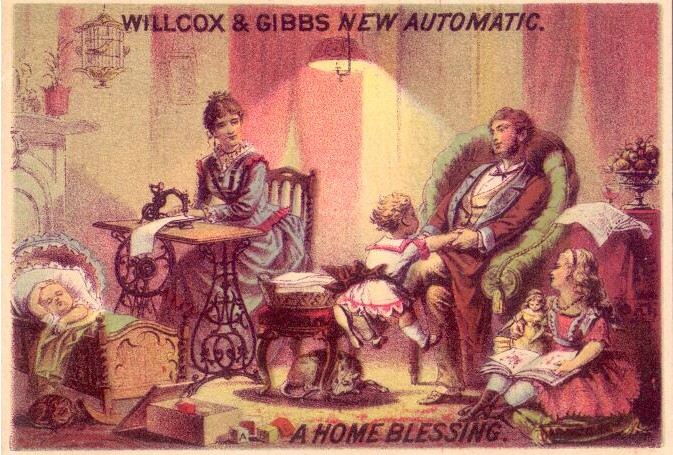
There are clever cards that reveal a hidden message when held to the light, and there are cards which can be folded for a particular effect, but even ordinary cards can show wry wit, humor, and whimsy. Take this wonderful example from the Standard Sewing Machine Co.:
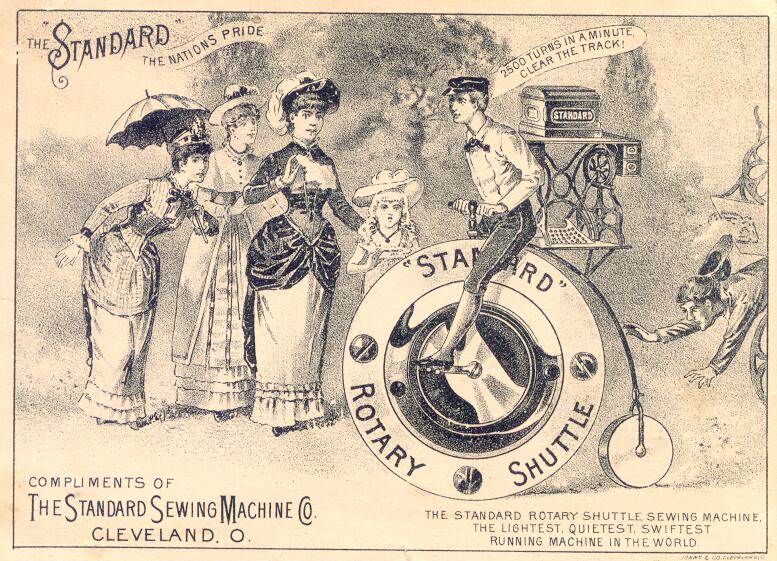
The card promotes not only the machine but also its rotary shuttle, which becomes the main wheel for a penny-farthing; the bobbin becomes the smaller rear wheel. The boy racing the bike shouts, "2500 turns in a minute! Clear the track!" Just in case we've missed the point, text at the bottom adds that the Standard is the "swiftest running machine in the world".
This early two-color card was issued by the Weed Sewing Machine Company:
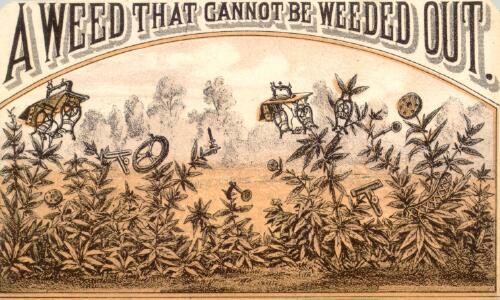
It's a curious approach to advertising. The manufacturer was actually surnamed Weed, and he didn't hesitate to name his sewing machine after himself. That much is understood. But how he thought this particular play on words would benefit sales is beyond me. After all, a "weed that cannot be weeded out" is a nuisance! Moreover, the Weed sewing machines (and attachments and parts) are the only weeds in the picture that are not firmly rooted!
Singer wasn't above the use of puns, either. These two cards from 1880 show New Family Model 12 sewing machines in use by the devil and an angel/cupid/cherub.

Biblical quotations are presented tongue-in-cheek for the amusement of the reader. The devil's illustration has the caption "And the devil came and sewed tares," while the angel's caption is "what I have sewed together let no one rip asunder."
In this card for the No. 7 American sewing machine entitled "An Attachment for their Teacher," boys are playing tug-of-war with the headmaster's coat-tails.
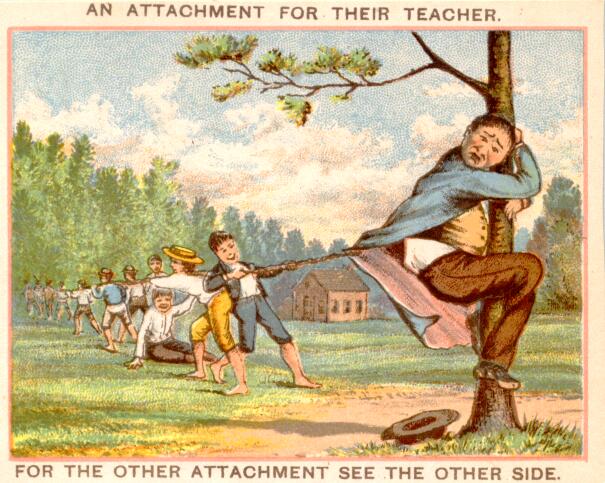
On the reverse side is a promotion for a buttonhole attachment.
Trade cards can give us new insight into the mindset of the era. Many depict scenes that might actually have taken place in the Victorian household. Purchase of a sewing machine was not undertaken lightly, and the arrival of the new household helper was cause for celebration. Witness the womenfolk clapping for joy on this card from 1878, appropriately entitled, "Arrival of the No. 8 Wheeler & Wilson":
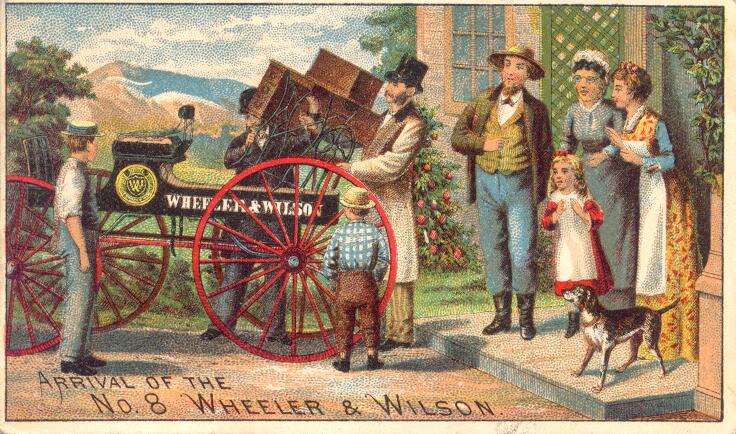
Whether they were preserved because of their decorative charm or for use as a reference, trade cards succeeded in promoting sewing machines to potential customers of the Victorian era. They were kept and enjoyed -- and preserved for us! Today, sewing machine collectors can learn a great deal about the machines and their first owners by studying these cards, and a trade card collection makes a fitting adjunct to a collection of 19th-Century machines.





